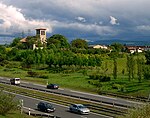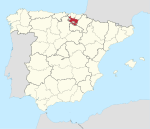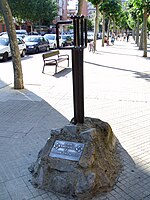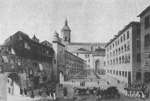Abetxuko Bridge

The Abetxuko Bridge is a steel girder bridge with organic forms in Vitoria-Gasteiz, Álava, Basque Country, Spain.The Abetxuko Bridge over the Zadorra River is one of several projects being built by Vitoria council to improve mobility for its citizens and, above all, for the inhabitants of the Abetxuko area who for several decades have only been able to reach the city centre via an old, 6-metre (20 ft)-wide bridge. The narrow deck on the old bridge only has space for two carriageways and a narrow pedestrian walkway. Crossing the bridge was risky for pedestrians as they are so close to the traffic, a danger which the council decided to eliminate in 2005. Also the old bridge had limited hydraulic capacity. It remains just to the east of the current bridge. The construction of the bridge was also central to the regeneration plan for the area (the green corridor of Vitoria). The project was intended to improve the mobility between the Abetxuko neighbourhood and the centre of Vitoria, connecting the neighbours physically and socially.
Excerpt from the Wikipedia article Abetxuko Bridge (License: CC BY-SA 3.0, Authors, Images).Abetxuko Bridge
Abetxukobidea/Carretera de Abetxuko, Vitoria-Gasteiz Abetxuko (Abetxuko)
Geographical coordinates (GPS) Address External links Nearby Places Show on map
Geographical coordinates (GPS)
| Latitude | Longitude |
|---|---|
| N 42.8728 ° | E -2.6817 ° |
Address
Abetxukobidea/Carretera de Abetxuko
01013 Vitoria-Gasteiz, Abetxuko (Abetxuko)
Autonomous Community of the Basque Country, Spain
Open on Google Maps











